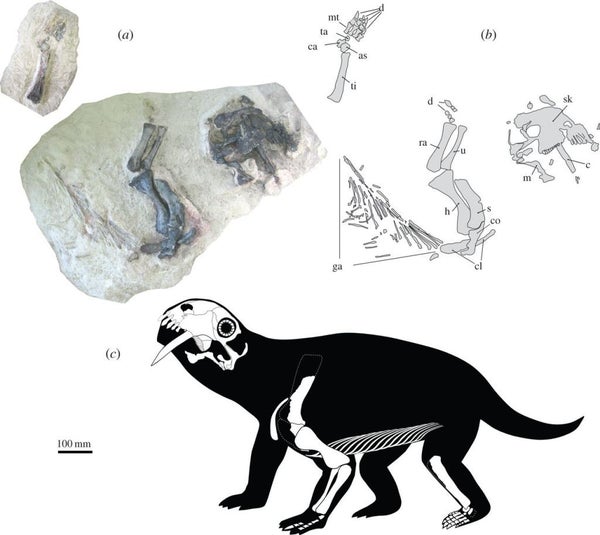This article was published in Scientific American’s former blog network and reflects the views of the author, not necessarily those of Scientific American
When I hear the word sabertooth, my mind immediately jumps to the great sabercats who sliced through throats and bellies with their impressive fangs. But that only represents one lineage and one way to be a sabertooth. Over 265 million years ago, one of the earliest creatures to bear saber fangs was an herbivore that likely used its impressive dentition in competition rather than carnivory.
This dawn sabertooth, Tiarajudens eccentricus, was named by Juan Carlos Cisneros and coauthors back in 2011. It was a synapsid – a protomammal more closely related to our early ancestors than to reptiles – that more specifically belonged to a group of plant munchers called anomodonts.
Tiarajudens, found in Brazil, is extremely similar to another animal found in South African rocks of about the same age called Anomocephalus africanus. In addition to molar-like teeth on their palates, both had expanded cheek teeth in the lower jaws that helped form a grinding surface. These were the earliest protomammals capable of chewing their food rather than tearing it up and gulping it down. But they didn’t chew just like we do. Those lower teeth ground against the molar-like teeth of their palate. Imagine if your jaw bones were rearranged so that your lower molars abutted against another set on the roof of your mouth.
On supporting science journalism
If you're enjoying this article, consider supporting our award-winning journalism by subscribing. By purchasing a subscription you are helping to ensure the future of impactful stories about the discoveries and ideas shaping our world today.
If they weren’t found in what once were different basins, the two protomammals might be considered different species of the same genus or even variations of just one species. As it stands now, they’re kept separate by two factors – geography, and the impressive fangs of Tiarajudens.

The skeleton of Tiarajudens. Credit: Cisneros et al. 2015
There’s no standard definition for what a sabertooth is. The title has been applied to animals with canines that are just look a bit long as well as to species like Tiarajudens, whose fangs were 120% of the animal’s skull height. And even though the fangs of Tiarajudens were relatively strong, Cisneros and coauthors write, the rest of the protomammal’s teeth suggest a diet of Permian greens. Why, then, did this species evolve such impressive teeth?
It’s possible that Tiarajudens used its saberteeth to slice plants rather than flesh. Yet Cisneros and colleagues didn’t find any evidence of wear on the teeth that would suggest puncturing or slicing vegetation. Instead, the researchers write, modern sabertoothed herbivores might hold the answer. Male musk deer and mutjacs have elongated canine teeth much like those of Tiarajudens, and they flash their fangs at each other when they get all het up during the mating season. If the visual deterrent doesn’t work, the deer scratch at each others flanks until one of them gives up.
Frustratingly, only one Tiarajudens has been found so far. We don’t yet know whether the long fangs were unique to one sex or possessed by both. As always, we need more fossils. But lacking any evidence that the protomammal used its teeth for feeding or defense, display is the leading hypothesis. Imagine two of these strange squat mammals facing off against each other, flashing their fangs in a form of combat that would evolve again and again in the following 265 million years.
Reference:
Cisneros, J., Abdala, F., Jashashvili, T., de Oliveira Buena, A., Dentzien-Dias, P. 2015. Tiarajudens eccentricus and Anomocephalus africanus, two bizarre anomodonts (Synapsida, Therapsida) with dental occulusion from the Permian of Gondwana. Royal Society Open Science. doi: 10.1098/rsos.150090
[This post was originally published at National Geographic.]